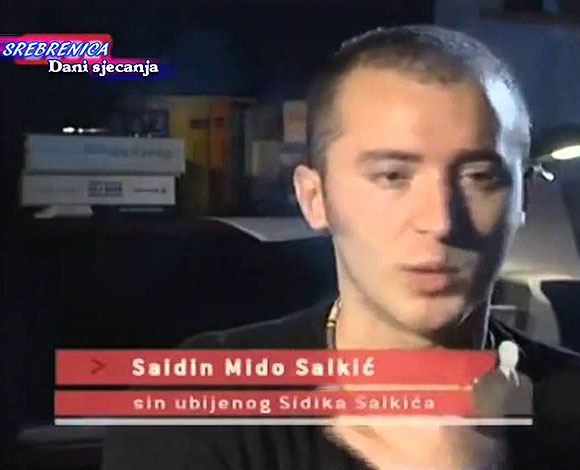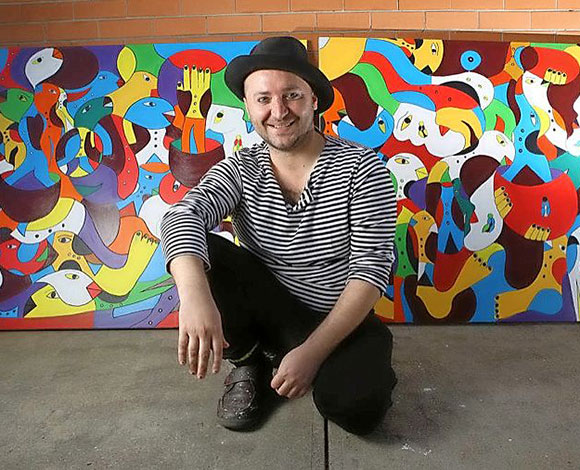Existentially and artistically, Saidin Salkic is transforming himself out of his dark night of the soul. It’s an ongoing process. When he was an adolescent in his homeland of Bosnia, in the early 1990s, the Yugoslavian war was at its peak. In the town of Srebrenica, his family experienced years of fear, followed by tragedy (the execution of Salkic’s father by Serbian forces), followed by despair and disorientation as they lived in camps and attempted to re-build their lives. Salkic himself was actually lucky to survive, as most teenagers were also killed alongside the men.
In 2001, the Salkic family – Saidin, his sister, and his mother – migrated to Australia. Slowly but surely, Salkic started finding his way, even if in the isolation of a new country. He started writing poetry, and his passion for art grew. To this day, he is a multi-skilled artist, creating works in the fields of poetry, fine art, music, and, of course, film. For me, he is one of Australia’s best filmmakers, making great films for about 12 years now, and one hopes for many more years to come.
His oeuvre currently consists of six films: Karasevdah: Srebrenica Blues (2007, 44 mins), Konvent (2010, 54 mins), Manifesto of a Defeated Poet (2016, 64 mins), Waiting for Sevdah (2017, 40 mins), Robbery of a Truffle Truck (2017, 33 mins), and The Arrival of a Phoenix (2018, 40 mins).
Generally speaking, his work is in the mode of “psycho-self-portraiture” let’s call it. He expresses and analyses himself (his life, the tragedy that happened) by appearing in all his films, and also utilising first-person narration, in work that is basically a portrait of himself (different aspects over different films). Genre-wise, he works in the broad area of “experimental cinema”, though I’ve never heard him use the word “experimental” to describe his films. Which gives you some idea of the uniqueness of his work (though his work does echo previous self-portraiture work by figures like Dwoskin, Zahedi and the Klonaris/Thomadaki team).
Karasevdah: Srebrenica Blues, his first film, is the film he had to make of course. It’s the initial exorcist attempt for him, to oust the tragic devil that leapt into his heart in July 1995 when his father was killed. So, living in Australia, in 2005, he returned to Bosnia, and filmed his hometown, in a series of beautiful framings, of the hills and houses, beautiful framings however that are soaked in blood and loss. Salkic himself doesn’t appear much in this first film of his, though there is a heart-breaking but joyful opening scene of Salkic with a child, who laughs happily and innocently at Salkic and his big microphone, bringing laughter and joy out of Salkic also. In his voice-over through the film though, Salkic makes it clear: this is the innocence he was robbed of.
Karasevdah: Srebrenica Blues
We then don’t see any other people in the whole film, just the tableaux of the dwellings and landscapes. It’s like an art installation in a way, rather than “experimental cinema” as such. And the shots are all in twilight or dawn, or filtered down, creating a haunted feel. This is unlike his subsequent films, which have harsh night and harsh day as their main palettes. And there it is – Salkic’s voice, which he uses in almost all his films, intelligent, poetic, probing, a little edgy. A conventional “nostalgic” or “reminiscing” tone you will not find in his films. There is no sentimentality, even in remembering all the friends and relatives he lost. Salkic is like a vessel of truth. He won’t shock, with sensationalist images or anecdotes, he will just say it straight, that he lost his whole world. 8,000 of the community killed in the space of a few days, in a gruesome genocide. You get hit in the face when his camera pans over a memorial of names, the aforementioned 8,000, and when it gets to the name “Salkic” there are over 50 of them. Okay, they weren’t all related to Saidin, but you get my drift.
Which immediately puts the notion of Salkic doing “self-portraits” into relief. He is not solipsistic, or narcissistic. No matter how individual and gifted he is as an artist, his work is all about his experience, not about himself per se. Let’s call it the experience of an everyman, but an “everyman in trauma”. Anyone who watches Karasevdah would have no doubt regarding its integrity. In its unusual way, it draws a powerful picture of the genocide, it truly feels for the killed people, and the devastated family members left behind. Not surprisingly, it screened in many cities worldwide, including in human rights contexts. It should also be noted that Salkic has appeared at war crime tribunals at The Hague in recent years.
His second film, Konvent, nails his personal narrative. His homeland, his Balkan village, with its traditions and riches, has well and truly been left behind as he now finds himself in Australian suburbia of all places. But where else would he be, migrating from Europe? In some yuppie apartment or groovy sharehouse? With his mother and sister, Saidin lives in a quiet outer suburb, and we see how truly quiet it is. Not even a burst of colour and playful experimental music for the title sequence at the start can enliven the environment he finds himself in. It’s the empty space that a later film (Waiting for Sevdah) will magically fill up. But that’s later in Saidin’s narrative.
Konvent
Whilst Karasevdah was quite conventional and “proper” in many respects, Konvent truly smashes the paradigm open. It’s as if Salkic instinctively realised that the only way he could represent his Australian world was not through any intellectual construct (which any voice-over provides, for example), but through a more direct, primal, “un-mediated” representation of the real. His genius touch here is to leave the camera sound intact, with its hum and clicks and bumps. And use no voice-over. (A rarity in his cinema.)
Oh, the irony. You leave a devastated place of war and find yourself in a safe haven, but it’s barren, no life, no joy. We see Salkic in the plain suburban brick house, on his own, smoking, thinking, in the night, with its dull light, and in the bright colourful daylight, with no neighbours around – no life, no joy. It’s an uncompromising and powerful representation of displacement and isolation. It’s a raw, unadorned film, which I applaud for its realism.
Salkic, ever the searcher, tries something different for his next film. I believe he tries for a masterpiece, a polished but grand film, well planned and well-made. He collaborates with a known filmmaker, John Cumming, to make this happen. They work on the film carefully but very sporadically, and, unfortunately, it takes years to complete. Manifesto of a Defeated Poet has some beautiful things in it, but ultimately fails to come alive.
For a start, the polished elements clash with the raw elements (which Salkic loves – the bumpy camera movements and soft focus shots, for example), creating an inconsistent work formally. Secondly, the melancholia (as Salkic spells out in the voice-over) just doesn’t spark, it floats around the film as a construct, but we don’t feel it in the images and actions we are seeing. Salkic has cited Butoh dance as his influence here, for some of his movements we see in the film, but I would suggest that the problem is that cinema is cinema, it is not dance (or other art forms). The film also overuses its symbols, like the red/blood and the baby cradle, bludgeoning us with them. This creates a bombastic feel, which doesn’t allow the viewer to enter the film, to truly experience the feelings at hand.
Manifesto of a Defeated Poet
But maybe that makes sense. Walking around and brooding, Salkic understands that he’s melancholic, searching for love, and desperate, his alienation in being in a new country deadening him to any new feeling. In a way, we feel that cul-de-sac. The first 20 minutes or so of this 64-minute film work quite well, with the jarring piano music, and Salkic’s bodily presence in the industrial landscapes of Melbourne’s west. There’s also the novelty of the voice-over making political commentary on the “fascistic capitalists” of Australia. So the film isn’t a total bust.
After the protracted, five-year production period for Manifesto of a Defeated Poet, Salkic felt the need to do something quickly and spontaneously again (like Konvent). In the meantime, over those five years, something changed in Salkic’s life – he brought a child into the world, a girl. The significance of this cannot be over-estimated, considering Salkic’s history. So, in early 2017, he made a film featuring the girl, whose name is Sevdah.
Waiting for Sevdah is like a miracle, one of the most sublime films ever made in Australia. Set in the suburbia of Konvent again, with its empty streets and lifeless houses, we see Salkic again, but he is not brooding this time. We first see him washing the blood (from Manifesto of a Defeated Poet) off his hands, in a symbolic shot, obviously, but a shot handled neutrally. Symbolism, because it’s so loaded, should always be “deflated” if you like, and Salkic understands that for this film. After a sequence where we see him in his house at night, his voice-over discussing his agony and how music will end it, we see him out on the empty suburban streets, incongruously dressed in black clothes with heavy eye make-up on, looking at a plane, and the sun. In a “silent comedy capers” moment, with piano accordion bursts on the soundtrack, we see him running down the street awkwardly. Is he checking the street? Is he “owning” it, “preparing” it?
And then, he sits on a chair in the middle of the street (no cars are driving by here, it’s very safe!), and a bell rings on the soundtrack (and keeps ringing), and Salkic smiles with breathless anticipation and joy. It’s an overdone gesture, comic, but in this case (unlike with the symbolism) overstatement is welcome, creating an expression on his face that is bizarre but fitting. Having seen the time on his clock inside his house in the previous scene, he knows that Sevdah will be here any moment. The film draws it out, lots of shots of the empty footpaths, and, finally, she appears, wheeling a bicycle (with learner wheels) down the footpath.
Waiting for Sevdah
And wheeling and wheeling it, over several minutes, in a magically elongated sequence that owes much to silent cinema and surrealist cinema. Salkic the director obviously is in stunned “epiphanic” mode here – it’s taken him 10 years and 4 films to bring another human being into his films, and he wants us (and himself) to savour the moment. Fun and frivolity ensue in the back yard, and piano music plays joyfully, with natural sounds mixed in. Salkic steps back from the playing Sevdah and observes her, and his heart breaks. It’s that kind of film. And there’s nothing corny about it whatsoever. After some rest, she sleeps over, and it is the most peaceful night-time scene in all of Salkic’s oeuvre – the dark/night is usually a place of foreboding or terror in his cinema. Some philosophical reflections on life and death from Saidin’s voice-over close the film, and it is a satisfying end to a film that is unbelievably good.
What I especially love about Waiting for Sevdah is the simple, intimate production values it has. Salkic has always been fond of awkward camera movements and shots that are not polished or worked, but here he pushes that a bit more, by intentionally making the shots even more soft focus, or more jagged. It’s the opposite of an “industry film” as it were. The editing in this film is also well-judged, more than in any of his other films, nothing feels extraneous, and some of the montage is just simply inspired.
The next film, Robbery of a Truffle Truck, takes the idea of “low production values” to a new level, as Salkic seems to use a flimsy Go-Pro camera to film with. It creates some interesting effects, giving the images a shuddering quality. This adds to the film. Which, of all things, is a fictional film, the only one Salkic has made, featuring himself again, and only himself, but clearly playing a character this time, someone who is attempting armed theft. It runs like an “experimental thriller”, let’s say, like a portrait of a deranged individual, tense and sweating in the night. He may be a thief according to the film, but he feels more like a killer, the gun in his hand.
Robbery of a Truffle Truck
After the joy of Waiting for Sevdah, where did this film come from? It’s clearly the dark to Sevdah’s light. Most of the film is set at night, with a throbbing drum soundtrack, but about half way through the film, we are in sunny suburbia again, and the front title sequence occurs (Salkic loves to present the titles in odd places in his films!), with one of Salkic’s songs on the soundtrack – “Take a walk through the streets of hell / I hope you’ll feel / if you don’t you shall”. I guess for some people suburbia is a hell and they find violent ways of trying to bust out of it. A curio of a film from Salkic, but its portrait of terror (including inner terror) is creative and convincing.
The Go-Pro camera is also used in his next film, which is his most recent film at the time of writing this, The Arrival of a Phoenix. After five films where each film was wildly different to its predecessor, Salkic seems to step backward a little, making like an alternate version of Waiting for Sevdah – another film featuring himself in a lighter mood, followed by the magical appearance of his daughter Sevdah again. But whereas the earlier film was grounded, realistic, microcosmic in a way, The Arrival of a Phoenix is ethereal, mystical, and quite macrocosmic, as it seems to begin with Salkic’s symbolic “arrival onto earth”, and finish with a feeling of eternity, in the sun, sea, sand. Again, it’s using symbols, but they are not overdone as in Manifesto of a Defeated Poet.
The film is transcendental. Firstly, it is guided by the soundtrack, which is mainly the sound of tinkling bells (or chimes), which is so insistent that it mesmerises us, and it fits perfectly with the airy, light images, of the air, the water, and the joyful faces of Saidin and Sevdah. The film culminates in its last 10 minutes or so with a sublime sequence of the two of them at the beach, and as Saidin looks at his daughter and her dress blowing in the wind (this shot of the dress is one of the most mystical shots I’ve ever seen on the screen), he has a Nietzschean “eternal return” moment: yes, I would live my tragic life over and over, if this moment also exists.
The Arrival of a Phoenix
Salkic is not your ordinary filmmaker. His personal history has marked his work in a particular way, and he is also like a filmmaker in exile, trying to adapt to a culture incredibly different to his own. His personality is also larger-than-life. He can be humble and loving, but he can also be grand and arrogant. At Q&As of his films, he is not a polite figure like most Australian filmmakers. Far from simply dismissing Hollywood, he will also dismiss Tarkovsky or Bresson. And proclaim himself a “great artist”. He expresses himself fully, he doesn’t play games.
Too experimental? Too hot to handle? Too outspoken? He is exactly what Australia needs right now, a unique filmmaker with a willing attitude.
(With thanks to Adrian Martin.)
Bill Mousoulis is a Greek-Australian independent filmmaker since 1982, and occasional writer on film.
|


